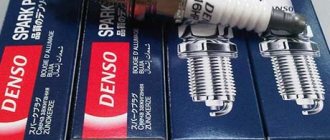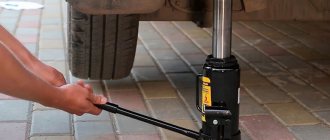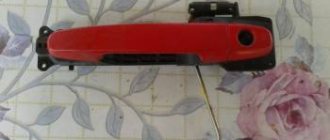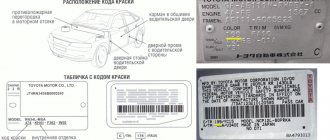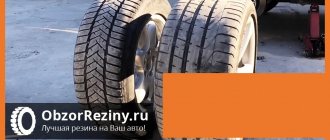All suspension elements fail over time and require replacement or repair; Camry 40 shock absorbers are no exception. They consist of racks with rods that dampen vibrations of shock-absorbing springs, as well as other elements. Often the Camry 40 strut or spring fails, thereby creating discomfort while driving.
With the emergence of these problems, drivers have questions about how to accurately determine the suitability of shock absorbers, which ones are best to buy and how to replace them. This is exactly what will be discussed in the article.
Signs of shock absorber failure
Click to enlarge
You can detect a breakdown of the Camry 40 struts by the behavior of the car during operation, or visually when inspecting the suspension. Most often they appear when driving:
- Car body roll during acceleration and hard braking is the most common symptom of a faulty Camry shock absorber. Ideally, after a sudden stop, the car body should swing no more than once. Otherwise (if it swung 2, 3 times) it’s worth inspecting them.
- Rocking of the car when turning is another sign that indicates that the shock absorbers are faulty or completely out of order. In this case, the roll in the transverse plane of the body is taken into account.
- An increase in braking distance is a sign that is usually accompanied by swaying of the car. As a result of increased braking time, faulty shock absorbers are not able to immediately extinguish inertia and the front part of the body sways up and down several times. This reduces the load on the front wheels, which impairs the performance of the Camry's brakes. This is especially noticeable in cars equipped with anti-lock brakes.
- If, when driving, the car “does not obey” - it is constantly pulled to one side, this also indicates a breakdown or partial failure of the Camry 40 strut.
- A feeling of discomfort when driving, which can be expressed in different ways for both the driver and passengers.
Typically, after these symptoms appear, drivers perform a visual check to pinpoint the problem and determine whether the Camry strut needs to be replaced. This is done because such signs occur when other parts of the suspension or brake mechanism of the Camry 40 break down. First of all, pay attention to the following signs:
- Oil drips on the Camry strut housing and rods, which occur when the sealing elements wear out. Loss of hydraulic fluid volume reduces shock absorption and increases wear on moving parts.
- Abrasion and damage to seals. Due to the decrease in the elasticity of the rubber, the mobility of the hinge joint deteriorates, the Camry struts wear out, which is reflected in discomfort when driving the car.
- The presence of mechanical damage and other defects on the body of the racks, breakage or wear of fasteners indicates the need to replace them.
- One-sided tire abrasion. Most often, when a Camry 40 shock absorber fails, more wear occurs on the inner part of the tire.
If you notice one or more signs indicating a malfunction of the racks, you should immediately fix the problem. Otherwise, it may cause damage to other suspension components.
How to understand when it's time to change the springs
To determine when one or more Camry 40 suspension springs need replacing, consider the following factors:
- Spring sag in Camry 40 during visual comparison when the interior and trunk of the car are not loaded (no cargo or passengers). This involves inspecting either the two front or two rear springs, depending on where the problem is likely to occur. If the difference is significant, it means the spring has sagged or burst and must be replaced immediately. Sometimes the cause of subsidence is a failed glass, while the Camry 40 spring itself is in excellent condition.
- The appearance of peculiar metallic sounds when driving over uneven surfaces indicates a burst or cracked spring. Similar clangs and metal knocks are also observed when the ball or steering axle of a Camry fails.
- Reduced ground clearance even when the car is lightly loaded also indicates a problem with the springs. This is usually inherent in the rear part of the suspension, when the wheels rub against the fender liners at jumps, and the mud flaps drag on the ground. In such situations, it is worth contacting a car service center to prevent critical wear of your Camry tires.
- Vibration and shaking when driving, regardless of the condition of the road, which increases as the vehicle accelerates. This sign indicates that the spring has completely burst and requires replacement.
- Another sign of a faulty spring is a decrease in the smoothness of the car or a significant roll when braking.
Usually, when these symptoms are detected, they immediately contact a car repair shop for a full diagnosis of the suspension, since the signs of failure of some Camry suspension elements often coincide.
Analogues of rear shock absorbers Toyota Camry XV40
The rear shock absorbers of the Camry 40 have a rather large stroke of the rod, and with serviceable springs that have not sagged, it is very difficult to break through such shock absorbers to the rebound, which allows you to safely transport cargo or several passengers in the back seat.
| Manufacturer | Front left | Front right | price, rub. |
| Tokiko | B3329 | B3328 | 6500/5400 |
| KYB Excel-G series | 339020 | 339025 | 4200 |
| KYB series New-SR | NST5376L | NST5376R | 12200 |
| Sachs Super Touring series | 313453 | 313452 | 7900 |
| Monroe series Original | 72310ST | 72309ST | 5100 |
Shock absorber Monroe 72310ST
Shock absorber Sachs 313453
What shock absorbers should I choose for the fourth generation Toyota Camry?
The KYB shock absorbers of the Excel-G series are most popular with the owner of the Camry 40; they are approximately 30-40 percent cheaper than the original ones. According to car owners, KYB shock absorbers, Excel-G series, are no different in driving performance from the original shock absorbers, the car is just as soft to drive and comfortable. But the manufacturer Kayaba also offers for the fortieth Camry, shock absorbers of the New-SR series - these are shock absorbers of a special series, externally they are distinguished by a sky blue body color, and are able to change their stiffness depending on road conditions. Since at high speeds on a flat road, the shock absorbers become stiffer, giving the car better handling and stability on the road, and at low speeds on roads with poor surfaces, they can become softer, thereby increasing the smoothness of the suspension and driving on uneven roads becomes more comfortable. Therefore, if the budget allows, then they take just such adaptive ones. But it’s worth noting that if you want to install the KYB New-SR, then it’s not enough to assemble one pair, they must be on all 4 wheels! If you are considering regular racks from other manufacturers, then: Kayaba - medium hard, Monroe - soft, but Bilstein will be the hardest. KYB shock absorbers of the Excel-G series are often chosen as analogues, since such shock absorbers allow the car to have the same driving performance as with the original shock absorbers, and they are cheaper. It’s better to take NSK or Koyo bearings - the same ones that come in the box with the “Toyota” label at half the price.
Self-check of racks
Considering the complexity of the design of shock absorber struts on modern cars, including the Camry 40, it is better to carry out diagnostics in special car repair shops. However, if you wish, you can check it yourself. There are three simple ways to do this - by car behavior, visual check and body rocking check.
Rocking the body
This method is caused by rocking the rear or front part of the body, depending on where the problem was noticed. In the process, it is necessary to apply force by pressing on the hood (if you are checking the front springs), thereby rocking the body. If after several swings the car makes 2 or 3 swings, then the suspension malfunction is obvious. Otherwise (with one vibration), everything is in order with the shock absorbers, but it is better to be on the safe side by checking them visually. The disadvantage of this method is that it is not suitable for all cars.
Visual inspection
This method of checking can be conveniently performed by driving the car into an inspection hole or lifting it on a lift. Ideally, the Camry shock absorber should be removed, but if you don’t have time, you don’t have to do this. The following factors are taken into account during the inspection:
- Oil stains on the shock absorber body and rods. In this case, wipe off the oil and dirt with a rag and leave the car for 2-3 days. If the leaks appear again, the Camry 40 struts need to be replaced.
- The presence of rust and mechanical damage indicates a malfunction of the racks.
- Check tire wear. If the tires on the inside are worn out more than on the outside, then a full diagnostic of the Camry suspension should be carried out.
- When inspecting, you should pay attention not only to shock absorbers, but also to other elements of the suspension and brakes. It definitely won’t be superfluous.
In move
Driving diagnostics are more suitable for experienced drivers. If the Camry 40 struts are damaged, then the car will behave differently, but this is not easy for a beginner to notice, especially if the car is used. During the test, the car is accelerated to a significant speed, maneuvers are performed and the brakes are sharply applied. If the shock absorbers are faulty, the car will move sideways, and when braking, it will noticeably sway and roll.
When to change struts
Each manufacturer declares its “guaranteed” mileage. On average it is about 70,000 km. But in practice, these elements do not last that long. This may be due to driving style, the general condition of the vehicle and the quality of the roads.
Therefore, it is recommended to visit a service station every 20,000 km for a routine inspection or immediately after discomfort occurs while driving. It is difficult even for an experienced driver to check the condition of the shock absorber struts on their own; it is better to leave this to a specialist.
If, during diagnostics, the performance of the racks is estimated at 50-60% or lower, they will need to be replaced soon.
Replacing rear struts and springs Camry 40
Replacement of rear struts with springs on Toyota Camry 40 cars is carried out on a lift. You will also need the following list of tools for work:
- lifting device;
- air gun;
- heads for 10, 12, 13, 19 and 21 mm;
- key to 19;
- spring tie device;
- ratchet.
The replacement itself is performed in the following order:
- First of all, unscrew the mounting bolts of the rear wheels, then lift the car on a lift and remove the wheels.
- Next, unscrew the bolts securing the brake pipe and the upper mounting bolt of the stabilizer link.
- Then unscrew the 2 bolts securing the Camry 40 rear shock absorber and release the strut from the knuckle.
- The following actions are performed through the car interior. We remove the rear seat headrest and take out 2 decorative plugs that hide the nuts securing the rear sofa. We unscrew these nuts and move the seat forward.
- The Camry 40 shock mount mount is now accessible. We unscrew the support fasteners and remove the rear shock absorber.
- Then, using a zip tie, remove the spring from the strut.
- Unscrew the nut from the support mounting and remove it along with the boot and bump stop.
We assemble a new Camry 40 strut (having previously bled it) with a spring and supports and install it in the reverse order.
When replacing rear shock absorbers on a Camry 40, we recommend comparing old dismantled suspension elements with new shock absorbers.
